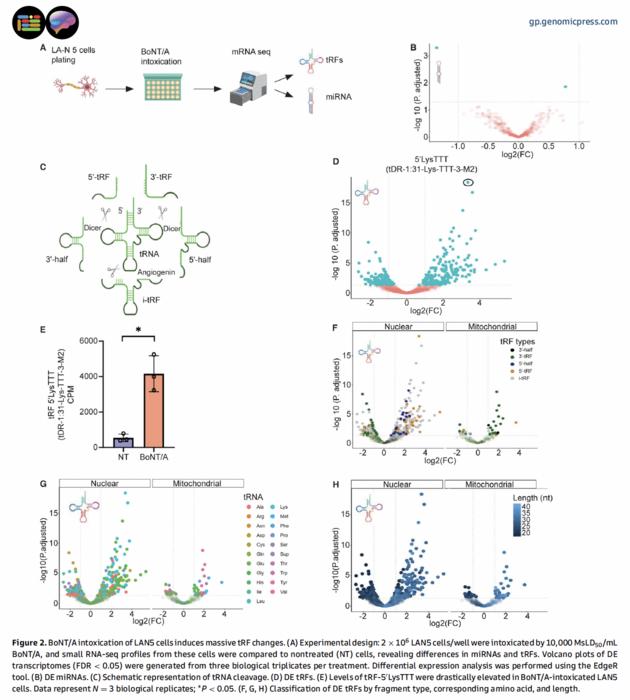In a landmark study published on May 20, 2025, researchers from The Hebrew University of Jerusalem have unveiled an extraordinary cellular mechanism that explains how neurons endure exposure to botulinum neurotoxin type A (BoNT/A), a toxin celebrated for its immense potency yet paradoxically used widely in medicine and cosmetics. The discovery centers on the role of tiny RNA fragments—specifically, 5’ LysTTT transfer RNA fragments (tRFs)—which act as molecular guardians preventing neuronal death even as the toxin potently disrupts neurotransmission. These findings could revolutionize the scientific understanding of neuronal resilience and pave the way for new therapeutic avenues targeting neurodegenerative disorders.
BoNT/A is notorious as the most lethal biological toxin, with a minimal lethal dose around one nanogram per kilogram. Despite its lethal capacity, this neurotoxin’s ability to reversibly inhibit synaptic transmission without killing neurons has puzzled scientists for decades. Until now, the molecular underpinnings of how neurons survive intact after BoNT/A exposure remained elusive. The multidisciplinary team, led by Dr. Hermona Soreq, deployed cutting-edge small RNA sequencing techniques to interrogate cellular responses in human LAN5 neuroblastoma cells exposed to BoNT/A, uncovering dramatic and selective alterations in RNA species that regulate cell fate.
A striking revelation from the study was that, rather than changes in microRNAs, which are traditionally recognized regulators of gene expression, the toxin exposure triggered a massive surge in tRFs. These small RNA fragments originate from precise cleavage of specific tRNAs, especially lysine tRNAs carrying the ‘TTT’ anticodon. The elevated presence of 5’ LysTTT tRFs appears to orchestrate a sophisticated molecular defense, interfacing with proteins and mRNAs involved in ferroptosis—a regulated form of cell death caused by iron-dependent lipid peroxidation.
Crucially, the team demonstrated that these tRFs bind to the heterogeneous nuclear ribonucleoprotein M (HNRNPM) and CHAC1 mRNA, impeding pro-ferroptotic pathways and thereby enhancing neuronal survival under toxin stress. This dual function allows BoNT/A to exert its neuromodulatory effects—effectively blocking neurosignaling—without triggering cell death. This mechanism represents an elegant cellular strategy to maintain neuronal integrity during toxic insult, challenging prior assumptions that toxin-induced paralysis might invariably precede neuronal loss.
Further molecular dissection revealed that approximately 20% of BoNT/A-induced tRFs share a conserved 11-nucleotide motif, “CCGGATAGCTC,” hinting at an evolutionarily preserved protective response. The detection of these sequence motifs in both human cell lines and rat nervous tissues underscores the biological significance and evolutionary conservation of this defense mechanism across mammalian species. The presence of this repetitive motif likely amplifies the protective effect, generating a robust “tRF storm” that fortifies neurons against oxidative and metabolic stress induced by BoNT/A.
The implications extend beyond the elegant resolution of a long-standing biological paradox. The delineation of tRF-mediated ferroptosis inhibition opens potential therapeutic vistas not only for refining botulinum toxin applications but also for addressing neurodegenerative diseases where ferroptosis contributes to neuronal loss. By manipulating these small RNA pathways, it may become feasible to develop agents that selectively bolster neuronal survival or fine-tune the duration and potency of botulinum treatments, reducing adverse effects and enhancing clinical outcomes.
Clinically, BoNT/A is utilized for a wide array of conditions including dystonia, chronic migraines, hyperhidrosis, and essential tremor, as well as its well-known cosmetic use for wrinkle reduction. Understanding the molecular crosstalk that preserves neurons during toxin exposure could empower the design of next-generation formulations with improved therapeutic indices or personalized dosing regimens. For instance, enhancing tRF production or mimicking their activity might prolong beneficial paralysis while safeguarding neuronal viability, maximizing treatment efficacy.
Furthermore, the study sheds light on why different botulinum neurotoxin serotypes exhibit distinct neurotoxic profiles. Serotypes such as BoNT/C and BoNT/E, which lack this tRF-based protective mechanism, tend to induce more overt neuronal damage, suggesting that the unique tRF-mediated pathway underpins BoNT/A’s relative safety and clinical utility. This insight provides a molecular rationale for serotype-specific effects and may inform future biotechnological refinement of botulinum toxins.
This discovery aligns with a growing appreciation of the non-coding RNA world as a dynamic regulator of cellular stress responses. The capacity of tRFs to modulate ferroptosis and stabilize neurons introduces a novel class of regulatory elements that function beyond conventional gene repression paradigms. Understanding how cells deploy tRFs as damage control agents could redefine therapeutic strategies that harness endogenous RNA fragments for neuroprotection.
Beyond immediate therapeutic implications, the findings invite exploration into whether similar tRF-mediated defenses operate in other pathological contexts such as traumatic brain injury, ischemia, or chronic neurodegeneration like Parkinson’s and Alzheimer’s diseases. If so, synthetic or biologically derived tRF mimetics might emerge as a new class of neurotherapeutics designed to forestall neuronal death across diverse neuropathologies.
The research by Dr. Soreq’s team leverages advanced transcriptomic profiling in cell culture models, employing three biological triplicates and robust statistical analysis via EdgeR to ensure confidence in their differentially expressed RNA datasets. Their integrative approach combining experimental intoxication protocols with high-throughput sequencing and computational biology represents a model for dissecting toxin-host interactions at nucleotide resolution.
As this work sees publication in the journal Genomic Psychiatry, it underscores the expanding intersection of genomics with neuroscience and toxicology. By revealing how small RNA dynamics underpin critical cellular outcomes, this study heralds a paradigm wherein RNA fragments assume central roles in neurobiology, toxicology, and therapeutic intervention strategies.
In summary, the identification of 5’ LysTTT tRNA fragments as pivotal agents blocking ferroptosis in botulinum-intoxicated neurons reveals an innovative mechanism of cellular resilience underpinning the clinical safety of BoNT/A. This breakthrough sets the stage for new molecular approaches to enhance neuronal survival and optimize botulinum toxin use, while enriching the fundamental understanding of RNA-based regulation in cellular stress responses.
Subject of Research: Cells
Article Title: 5’LysTTT tRNA fragments support survival of botulinum-intoxicated neurons by blocking ferroptosis
News Publication Date: 20-May-2025
Web References:
http://dx.doi.org/10.61373/gp025a.0047
Image Credits: Hermona Soreq
Keywords: Botulinum neurotoxin, BoNT/A, tRNA fragments, tRFs, ferroptosis, neuronal survival, small RNA, HNRNPM, CHAC1 mRNA, neuroprotection, neurodegeneration, RNA sequencing




